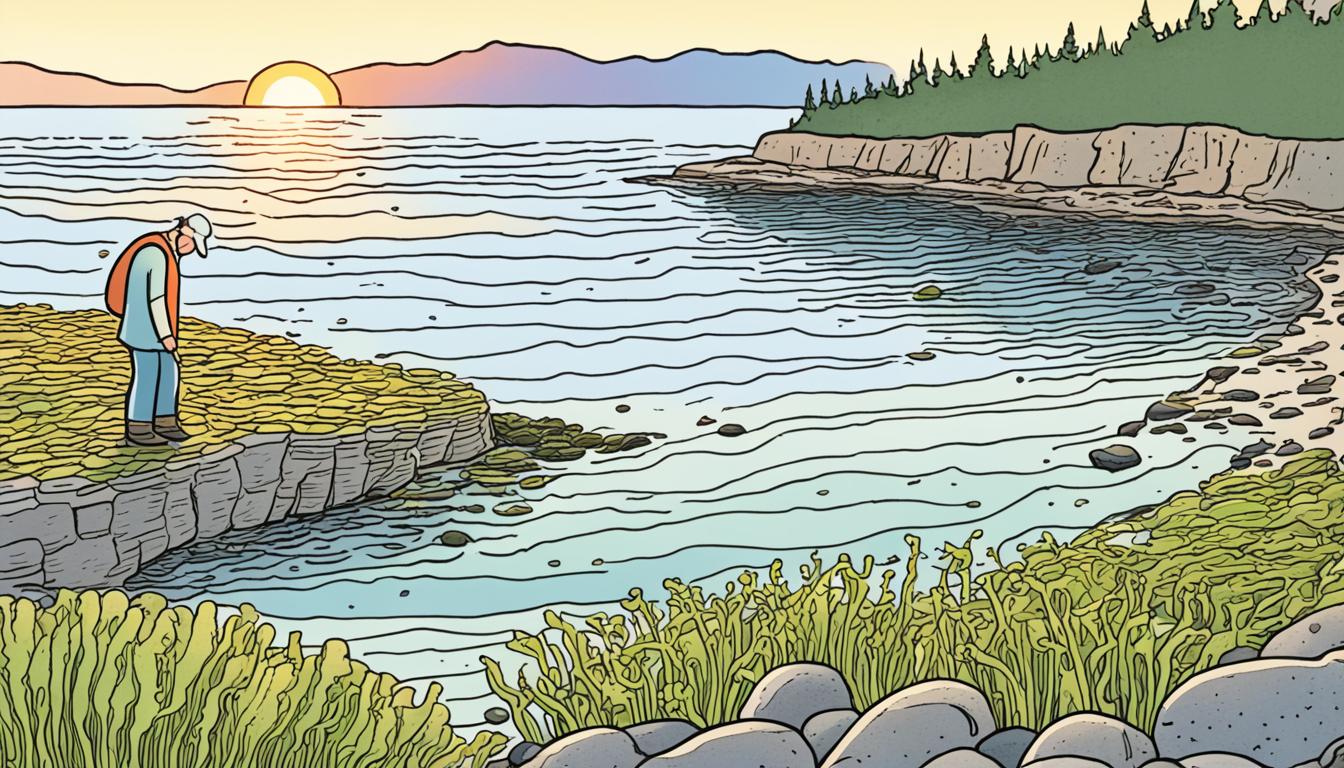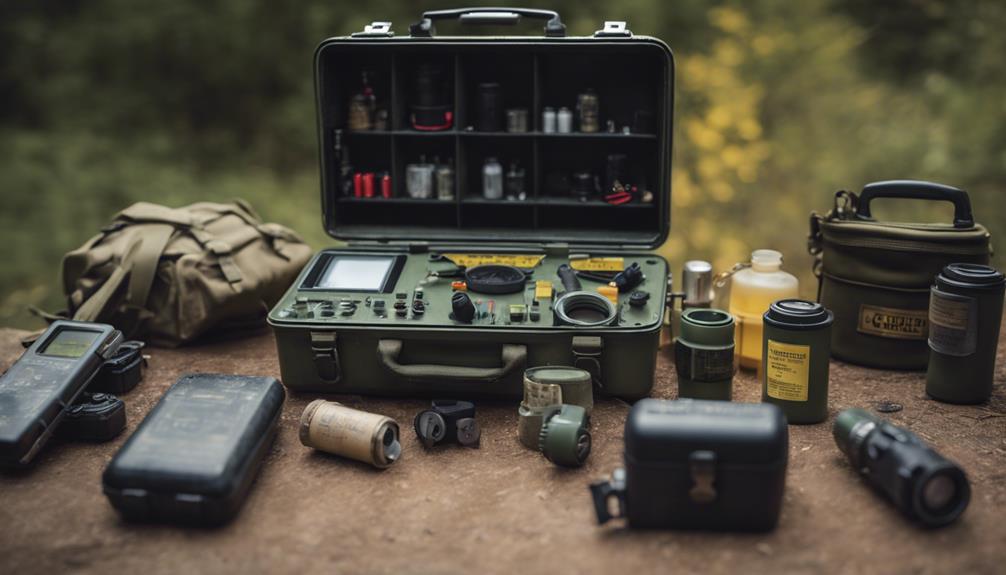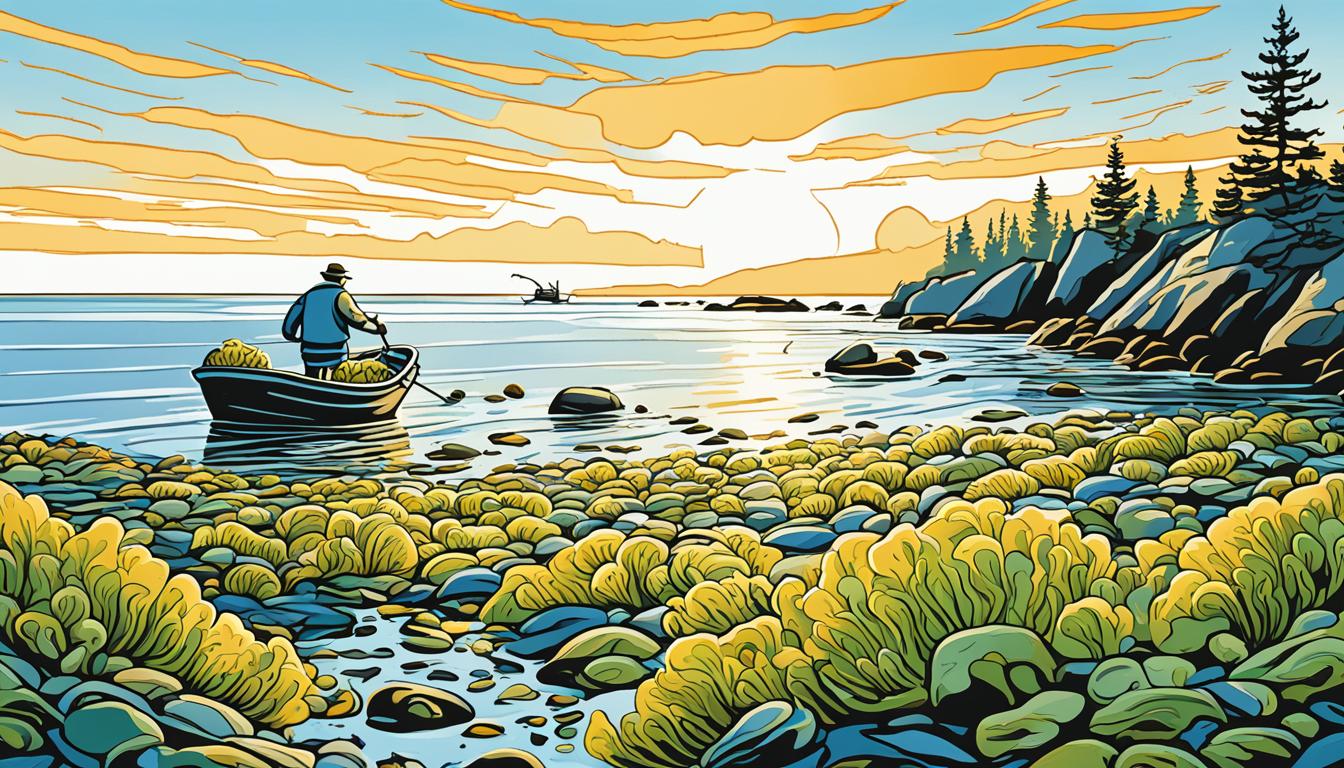Imagine strolling along the pristine shores of Florida, feeling the warm sand beneath your feet and listening to the rhythmic sound of crashing waves. As you explore the coastal ecosystem, you can’t help but notice the abundance of natural treasures just waiting to be discovered.
Coastal foraging in Florida opens up a world of possibilities, allowing you to connect with nature and indulge in the bounty of the ocean. From wild edibles to ocean plants, there is a wealth of resources available to those who know where to look.
Beachcombing becomes more than just a leisurely activity as you spot vibrant seashells, unique pieces of driftwood, and colorful sea glass. But the true adventure begins when you embark on a seashore hunting expedition, uncovering hidden gems of edible marine life.
Key Takeaways:
- Coastal foraging in Florida offers a bounty of natural items from the marine and brackish water environment.
- Wild edibles such as ocean plants and marine life can be discovered and collected along the coastal shores of Florida.
- Beachcombing and seashore hunting allow you to connect with nature and indulge in the ocean’s bounty.
- Exploring the coastal ecosystem in Florida unveils a world of vibrant seashells, driftwood, sea glass, and edible marine life.
- Coastal foraging in Florida provides a sustainable way to enjoy the natural resources found along the coast.
Shrimp: A Tasty Coastal Treat
Shrimp is a delicious and popular coastal delicacy that can be enjoyed in various dishes. If you’re looking to catch your own shrimp, there are a few methods you can try.
Cast-Netting for Shrimp
One way to catch shrimp is through cast-netting. This method involves using a fine 1/4-inch mesh net, which is effective in Atlantic and Gulf tidewaters. Cast-netting is typically done during nighttime under lights near bridges, docks, and jetties. Shrimp are attracted to the lights, making it easier to catch them in the net.
Deep-Water Shrimping
For those who prefer deep-water shrimping, this method is typically done in 15- to 30-foot-deep water using cast nets. Boat sonar can also be used to locate shrimp in deeper waters, increasing the chances of a successful catch.
Shallow-Water Shrimping
If you’re looking for a fun and family-friendly activity, shallow-water shrimping is recommended. This can be done from anchored boats, docks, and jetties in the coastal areas. To attract shrimp, using fish meal bait is a common practice. The scent of the bait will entice the shrimp, making them easier to catch with a net.
It’s important to be aware of state regulations regarding shrimp fishing, including recreational shrimping seasons, catch limits, and gear restrictions. By following these regulations, you can enjoy the thrill of catching your own shrimp while ensuring the sustainability of this coastal resource.
No matter which method you choose, fishing for shrimp is an enjoyable activity that allows you to connect with nature and indulge in a tasty coastal treat.
| Method | Tidewater | Water Depth | Bait |
|---|---|---|---|
| Cast-Netting | Atlantic and Gulf | N/A | N/A |
| Deep-Water Shrimping | N/A | 15-30 feet | N/A |
| Shallow-Water Shrimping | N/A | N/A | Fish meal |
Blue Crabs: Steamed Delights
Blue crabs are a popular seafood choice found along the coastal shores of Florida. Their delicate and sweet meat makes them perfect for steaming or using in crab cakes. If you’re interested in catching your own blue crabs, crabbing is a fun and rewarding activity.
You can catch blue crabs from tidal banks, docks, and bridges using various methods and equipment. One common method is using chicken necks or wings as bait to attract crabs. With a stout cord, you can lift the crabs to the surface once they’re lured in. Special tight-mesh crab nets are available for this purpose, making it easier to catch them.
If you’re looking to do more extensive crabbing, you can use lengthy cords with multiple baited lines. This allows you to cover a larger area and increase your chances of catching blue crabs. Commercial heavy-wire lift traps or larger crab traps can also be effective, especially if you’re targeting a larger harvest.
It’s important to follow state regulations regarding crab harvest, limits, and areas open for crabbing. These regulations are in place to ensure the sustainability of the crab population and maintain a healthy balance between male and female crabs for mating purposes. By adhering to these regulations, you can enjoy crabbing while also preserving the ecosystem.
| Statistical Data | Average |
|---|---|
| Eggs produced by female blue crabs | 2-2.5 million |
| Size of each egg in a female blue crab’s roe | 0.25 mm |
| Calories per 80 grams of crab roe | 100 |
| Grams of fat per 80 grams of crab roe | 6 |
| Grams of carbohydrates per 80 grams of crab roe | 8 |
| Grams of protein per 80 grams of crab roe | 4 |
So next time you’re craving some delicious blue crabs, consider trying your hand at crabbing. It’s a rewarding experience that allows you to enjoy the satisfaction of catching and preparing your own steamed delights.

Dungeness Crabs: West Coast Delicacies
When it comes to crabbing along the Pacific Coast, Dungeness crabs are the stars of the show. Known for their sweet, flaky meat, these delectable creatures are a favorite among seafood enthusiasts. If you’re looking to try your hand at catching Dungeness crabs, here are some guidelines to get you started.
Crab Traps and Fish Baits
The first step in successfully catching Dungeness crabs is to set up your crab traps. These traps, usually large square contraptions, are designed to entice crabs to enter and then keep them trapped until you retrieve the trap. To attract Dungeness crabs to your traps, fresh fish baits like shad, menhaden, mullet, and fish heads work wonders. The strong scent of these baits is irresistible to these crustaceans.
Crabbing Guidelines and Season
Before you head out on your crabbing adventure, it’s crucial to familiarize yourself with the crabbing guidelines specific to your state. Each state may have different regulations when it comes to the number of traps allowed, the size of the crabs you can keep, and the areas open for crabbing. By understanding and following these guidelines, you can ensure that you’re crabbing legally and responsibly.
Furthermore, it’s essential to be aware of the crabbing season in your area. Dungeness crabs have specific times of the year when they are most abundant and can be legally harvested. By checking the crabbing season, you can plan your crabbing trips accordingly and increase your chances of a successful catch.

Stone Crabs: Powerful Claws and Delicious Meat
Stone crabs, including Florida stone crabs and Gulf stone crabs, are known for their large and powerful claws, making them easily distinguishable in the world of crabs. These claws are the highlight when it comes to harvesting stone crabs, as they can be regrown by the crabs once released back into their natural habitat. This sustainable practice ensures the continued survival of the species while still allowing us to enjoy their delicious meat.
When it comes to cooking stone crabs, simplicity is key. The most common way to enjoy their meat is by cracking open the claws and sautéing it to perfection. The succulent and sweet meat provides a unique flavor that pairs well with various dishes. Stone crabs are a true delicacy, and their claws are highly sought after by seafood lovers.
However, it’s important to note that stone crab harvesting is regulated to protect the population and ensure their sustainability. State regulations set size and number limits on stone crab claws, and it’s crucial to familiarize yourself with these regulations to avoid any violations. By adhering to these rules, we can play our part in maintaining a healthy stone crab population for future generations.
Stone Crab Claws Pricing
When it comes to purchasing stone crab claws, there are different options available. “Select” claws are priced at $39.95 per pound, while “Jumbo” claws come at a higher price of $63.95 per pound. The choice depends on personal preference and the size of the claws that best suit your culinary needs.
Stone Crab Harvesting Regulations
The stone crab industry follows strict regulations to ensure sustainable harvesting practices. Fishermen engage in claws-only fishing, where only the claws are harvested. The rest of the crabs are returned alive to their natural habitat, allowing them to regenerate their lost limbs. This ensures that the stone crab industry remains renewable and supports the long-term health of the population.
Stone crab fishing trips can be rigorous, starting as early as 3-4 a.m. and lasting until 5-6 p.m. Fishermen endure long hours to ensure a successful catch, highlighting their dedication to the industry.
History and Conservation Efforts
“The stone crab industry in Florida dates back to the 1890s, and it has been an integral part of the state’s seafood heritage. Established in 1967, Keys Fisheries has played a significant role in the industry by providing hundreds of thousands of pounds of stone-crab claws.”
Conservation measures have been introduced to protect the stone crab population. In the 1970s, a proposal suggested limiting the harvest to one claw per crab, but fishermen often take both claws. Studies have shown that crabs have a higher survival rate when only one claw is removed, with an estimated survival rate of around 70%. However, for crabs with both claws removed, the survival rate drops to approximately 50%.
While the stone crab fishery in Florida is assessed as minimally to moderately renewable, efforts are made to ensure its sustainability. The industry claims to throw back most of the caught crabs to regenerate new limbs, and a significant portion of the crab catch consists of regenerated claws.
It’s worth noting that China has the largest crab fishery globally, accounting for 40% of the total catch. However, regulations in some parts of the United States and Europe forbid or limit claws-only fishing due to conservation and animal welfare concerns.
Stone Crab Festivals and Economic Impact
Stone crabs have a significant impact on the economy of Florida. The commercial harvest of stone crab claws supports local fishermen, processing facilities, and the wider seafood industry. The demand for Florida Stone Crab claws remains consistently high due to their succulent and sweet meat, coupled with sustainable harvesting practices.
Every year, the Stone Crab Festival celebrates the Florida Stone Crab and the rich seafood heritage of the region. The festival showcases diverse culinary offerings and seafood delicacies, paying homage to these delicious crustaceans.
The Stone Crab Fishing Industry
The stone crab industry heavily relies on fishing boats equipped with specialized gear and technologies for sustainable harvesting and adherence to regulations. These boats play a vital role in ensuring the careful and responsible harvest of stone crabs, maintaining the delicate balance between supply and demand while preserving the ocean ecosystem.
Now that you’ve learned more about stone crabs, their powerful claws, and delicious meat, you have a deeper understanding of this unique delicacy that Florida and the Gulf Coast have to offer. Remember to savor these delectable claws while honoring the regulations that protect them for generations to come.

Spider Crabs: A Unique Coastal Find
Spider crabs are a less commonly collected species but can be delicious when properly prepared. These crabs are often found under rock ledges and reefs in the Florida Keys, making them easily accessible for hand-catching. Along the Pacific Coast, spider crabs can be caught using live bait, hooks, and lift or umbrella nets. Spider crabs can be steamed and eaten whole or cleaned by removing the carapace shell and boiling the pieces with large pincers attached.
Spider crabs range from Nova Scotia through Florida on the East Coast and can be caught by hand in the Florida Keys or using hooks and lift nets out West. Their spindly legs and unique physique distinguish them from other crab species, with long appendages reaching out from their round carapace. While not as widely known as blue crabs or Dungeness crabs, spider crabs offer a distinctive culinary experience for adventurous seafood enthusiasts.
To catch spider crabs, a variety of techniques can be utilized. Along the Pacific Coast, where spider crabs are also found, live bait such as fish can be used to attract them. Hooks and lift nets are commonly employed to capture these elusive creatures. In the Florida Keys, hand-catching under rock ledges and reefs is a popular method due to their accessibility in shallow waters.
Once a spider crab is caught, proper preparation is key to fully enjoy its flavors. Steaming the crab is a common method, allowing the meat to retain its rich taste and tenderness. The entire crab, including its long legs and body, can be eaten, making for a visually stunning and flavorful meal.
Spider Crab Catching Techniques
Spider crabs have specific habits and preferences that can aid in successful catching. Here are some techniques used by experienced crab hunters:
- Identify potential spider crab habitats, such as rock ledges, reefs, and shallow coastal areas.
- Use live bait, such as fish or other crustaceans, to attract the crabs.
- Set up hooks or lift/umbrella nets in the water, ensuring they are securely anchored.
- Monitor the traps regularly to check for caught spider crabs.
- If hand-catching, carefully lift rocks or search under ledges in the Florida Keys.
Spider crabs offer a unique opportunity for coastal foragers to discover a lesser-known delicacy. Their distinctive appearance and delicate meat make them a sought-after ingredient for seafood enthusiasts. Whether caught by hand or with specialized equipment, spider crabs provide a memorable and flavorful addition to any seafood feast.

Bay Scallops: Savory Bivalve Mollusks

Bay scallops, indigenous to the East Coast and Gulf Coast areas of the US, are a delightful culinary option for seafood lovers. With their shells measuring up to four inches across, bay scallops are known for their savory, delicate, and sweet meat.
To enjoy the succulent flavor of bay scallops, snorkeling or diving in clear and shallow waters is the preferred method of collection. This allows you to hand-collect the scallops and select only the adductor muscle—a tender morsel that is typically consumed.
It’s important to note that in some coastal areas, regulations prohibit the harvesting of bay scallops for human consumption due to potential impurities found in regional waters. Therefore, it is crucial to stay informed about local and state scallop regulations to ensure that you are harvesting them safely and legally.
Bay Scallops Harvest
| Region | Size Limit | Number Limit |
|---|---|---|
| East Coast | No size limit | Check local regulations |
| Gulf Coast | No size limit | Check local regulations |
Bay scallops offer a delectable addition to your seafood menu, showcasing the bounty of the coastal regions. Whether enjoyed on their own or incorporated into delicious recipes, these savory bivalve mollusks are sure to please your taste buds and add a touch of elegance to any meal.
Oysters: Pristine Delicacies from Approved Waters
When it comes to seafood delicacies, oysters are highly sought after for their unique flavor and texture. These bivalve mollusks are a prized culinary delight that requires careful harvesting from pristine, state-approved waters along the coasts. Whether you’re a seasoned oyster enthusiast or someone looking to explore the world of seafood, oysters offer a taste of the ocean like no other.
Oyster harvesting is regulated to ensure the sustainability of these marine mollusks and the preservation of their natural habitats. Each state along the East Coast, Gulf Coast, and Pacific Coast has specific oyster regulations that govern the open season dates, harvest limits, and designated regions for oyster collection. It’s important to familiarize yourself with these regulations before embarking on your oyster-harvesting adventure.
One of the reasons oysters require harvesting from approved waters is to maintain their quality and safety for consumption. Oysters are filter feeders, meaning they absorb nutrients and substances from their surrounding environment, including water quality. By harvesting oysters from approved waters, you can be confident that the oysters you enjoy are free from contaminants and meet strict standards.
There are various methods for oyster harvesting, depending on the location and regulations. Some common methods include handpicking, using tongs, and using rakes. Oyster season can vary from state to state, typically aligning with favorable environmental conditions for oyster growth and reproduction. It’s always best to check with local authorities or your state’s regulatory agencies to determine the specific oyster season in your area.
Once harvested, oysters can be enjoyed in a variety of ways. They can be served raw on the half-shell, steamed, grilled, or used as a flavorful ingredient in seafood dishes. Oyster lovers appreciate the briny taste and creamy texture that make these mollusks so sought after.
To enhance your oyster-harvesting experience, consider exploring different oyster locations along the coasts. From Maine to Florida and beyond, these regions offer diverse oyster varieties, each with its own unique flavor profile. Whether you prefer the bracing saltiness of a Northeastern oyster or the sweet, melon-like notes of a Southern oyster, there is a wide range of flavors to discover.
Taste the Ocean’s Bounty with Oysters
Feast your senses on the ocean’s bounty with oyster harvesting. From the carefully regulated waters to the delectable flavors, oysters offer a culinary adventure that is as delightful as it is sustainable. So grab your shucking knife and embark on a journey to savor some of the ocean’s most prized delicacies.

| Key Points about Oysters | |
|---|---|
| Oysters are bivalve mollusks that require harvesting from approved waters. | |
| Each state has specific regulations for oyster harvesting, including open season dates, harvest limits, and designated regions. | |
| Oysters absorb nutrients from their environment, making approved waters crucial for their quality and safety. | |
| Harvesting methods for oysters vary, including handpicking, using tongs, and using rakes. | |
| Oysters can be enjoyed raw, steamed, grilled, or used in various seafood dishes. | |
| Explore different oyster locations along the coasts to discover diverse flavor profiles. |
Seaweed: A Unique Coastal Delight
Seaweed is not only fascinating but also a nutritious coastal resource that can be foraged and enjoyed. Along the California coast, you can find an abundance of edible seaweed, with over 640 different species available. From bladder wrack to nori and kombu, there are various types of seaweed to discover and incorporate into your diet.
When harvesting seaweed, it’s crucial to practice sustainable methods to ensure its long-term health. Remember to only gather a small portion of each individual plant, no more than 25%, allowing it to regenerate and contribute to the coastal ecosystem. By doing so, you can help preserve the balance of marine life and continue to enjoy the benefits of this incredible resource.
Seaweed is not just a nutritious addition to your meals; it also offers a unique flavor and texture. Bladder wrack, for example, can be used in salads to add a distinctive taste. Additionally, seaweed is a good source of iron and iodine, found in health food stores as well. Its high protein content, along with Vitamin B12 and omega-3 fatty acids, makes it a valuable dietary choice.
As seaweed foraging gains popularity, classes have become available to learn how to harvest seaweed safely. These classes, which can range from a few hours to several days, often include cooking lessons and can cost between $90 to $445. Some classes even teach the technique of harvesting seaweed from a kayak, providing a unique and immersive experience.
FAQ
What is coastal foraging?
How can I catch shrimp along the coast?
What is the best bait for catching shrimp?
How can I catch blue crabs along the coast?
How can I catch Dungeness crabs along the Pacific Coast?
How can I catch stone crabs?
How can I catch spider crabs?
How can I collect bay scallops?
Where can I find oysters for harvesting?
How can I forage and harvest seaweed?
Source Links
- https://www.fieldandstream.com/wild-edibles-to-forage-from-ocean-and-coast/
- https://www.popsci.com/story/diy/wild-ocean-edibles-coast-forage/
- https://fishyourassoff.com/how-to-catch-a-pompano-fishing-florida.html
- https://wholesaleseafoodusa.com/seafood-news-and-history/f/🦀get-the-most-meat
- https://www.yelp.com/search?find_desc=Crab Claws&find_loc=Fort Lauderdale, FL
- https://www.yelp.com/search?find_desc=Joes Crabs Shack&find_loc=Key West, FL 33040
- https://www.themeateater.com/fish/shellfish/sight-fishing-for-dungeness-crabs
- https://www.formerchef.com/2013/11/24/crabs-101-a-quick-primer-on-all-things-crab/
- https://www.atlasobscura.com/articles/stone-crabs
- https://holycrabdelivery.com/blog/10-things-know-florida-stone-crabs
- https://mattbuckinghamphotography.com/category/crab-spider/
- https://open.library.ubc.ca/media/stream/pdf/18861/1.0108115/3
- https://www.wusf.org/2022-07-24/i-went-seaweed-foraging-for-the-first-time-and-hit-the-mother-lode
- https://www.wlrn.org/2017-01-15/bountiful-beach-buffet-fresh-seaweed-is-making-waves-among-foragers










